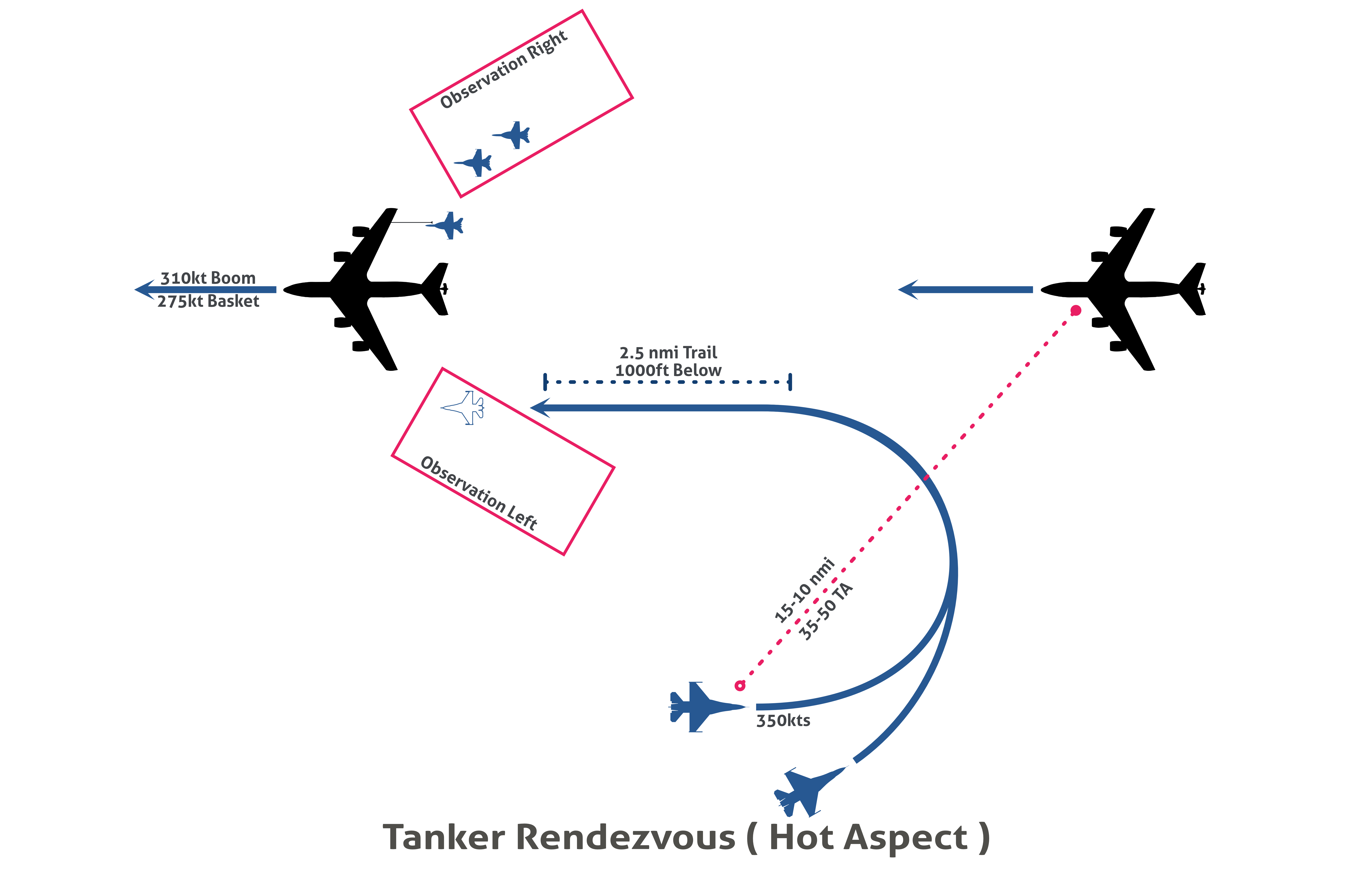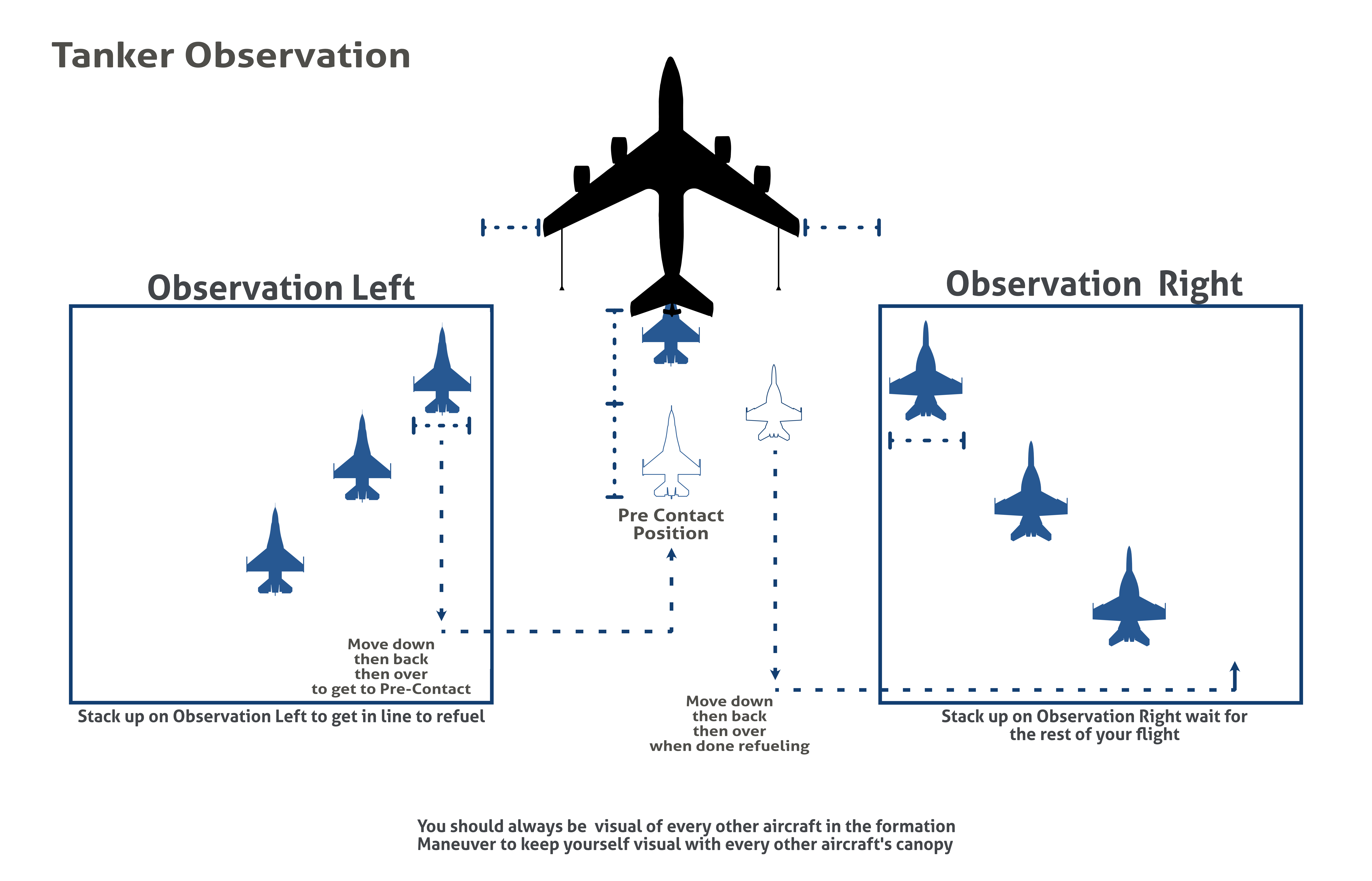Air-to-air refueling is one of the most critical and high-risk phases of an operation due to the potential for mid-air collisions. During this process, there may be 8-12 fighters in formation, each pilot focused on their fuel state, managing nerves, and configuring their jets. It’s crucial to maintain awareness of your position at all times.
Flight leads must ensure their flights rendezvous in a controlled manner, allowing them to maintain good situational awareness of the tanker and its receiving aircraft.
¶ AAR Rendezvous
¶ Rendezvous Comms
For tactical and planning purposes you should announce on your tactical channel to your C2 agency when you intend to leave the AO for a tanker, and which tanker you into to AAR with. This will help other flights know which tankers are in use.
Switch to the tanker’s frequency no later than 10 nautical miles slant range from the tanker. Wait 10 seconds before announcing your flight’s intentions. When ready, announce:
- Your flight’s relative direction, clock face, or bearing position to the tanker
- Your distance
- Flight aircraft type and quantity
- Low fuel state in your flight
(Fuel quantity in lbs / 1000)
Example:
“ARCO91, RAGE21 is 10 miles to the south, 4-ship F-16, low state 4.3”
If another flight is already on the tanker, the flight lead should respond with:
- Their callsign
- Aircraft type and quantity
- Number of aircraft still needing to tank
- Current low state of those aircraft
Example:
“RAGE21, RIPPER31 at ARCO91, 4-ship F-14, 2 aircraft to go, low state 5.8”
Once the arriving flight is 1000 feet behind the tanker and moving into Observation Left, announce: FLIGHT, rejoining left.
¶ Low Fuel Aircraft
Reasonable accommodations should be made for critically low fuel aircraft to tank immediately if they are the lowest state aircraft at the tanker. The current Flight Lead should pull their wingmen off the boom/basket when the arriving flight announces their rejoin. This should be done over the tanker frequency:
Example:
“RIPPER33, RIPPER31, disconnect.”
The wingman should respond with their intended observation position:
Example:
“RIPPER31, rejoining Observation Right, State 6.8” (still needs more fuel)
“RIPPER31, rejoining Observation Right” (Done refueling)
The arriving flight lead should send their low state aircraft to the pre-contact position directly, after confirming the previous aircraft is off the boom/basket and moving to Observation Left/Right.
If the tanker already has a flight with low fuel fighters and the arriving flight has a marginally low fuel fighter, consider an alternative tanker within 60-80 nautical miles.
¶ Hot Aspect Rendezvous ( Fighter Turn On )
Don’t enter a a direct tail chase of the tanker. Approaching the tanker directly in trail makes you difficult to see from the Observation Positions, and impossible to see from the Contact or Pre-Contact position.

When rejoining a tanker that is hot aspect to you, perform a fighter turn onto the tanker. Approach the tanker to place it 7 to 10 degrees off the side of your nose, maintaining that angle until the turning point.
- At ~10-15 nautical miles slant range from the tanker with a minimum of 10nmi lateral separation, and a TA of 35-50 (Larger TA for shorter range turns), execute roughly a 30-degree angle-of-bank turn towards the tanker at 350 knots, maintaining or descending to an altitude 1000 feet below the tanker.
- At the 90-degree point of the turn, you will want to see the tanker close to off your nose, and you will want to adjust your turn to place the tanker on the right of your HUD by the roll out.
- Roll out 2.5 nautical miles left of trail to the tanker, at 350 knots, 1000 feet below the tanker’s altitude.
- Maintain 350 knots until closure rates dictate an airspeed adjustment to match the tanker’s speed.
Proceed directly to Observation Left from your position, smoothly transitioning to the tanker’s altitude at least 1000ft from the tanker, and ensuring your flight is viewable to the canopies of the flights that are already rejoined on the tanker.
¶ Cold or Flanking Rendezvous
Don’t enter a a direct tail chase of the tanker. Approaching the tanker directly in trail makes you difficult to see from the Observation Positions, and impossible to see from the Contact or Pre-Contact position.
When rejoining a tanker that is cold aspect or flanking you, perform a normal fighter intercept, positioning yourself to perform a CATA intercept on the tanker.
- At 3 nautical miles slant range from the tanker, descend to 1000 feet below the tanker’s altitude.
- Discontinue the intercept and shift your flight to a 2.5 nautical mile left of trail chase on the tanker at 350 knots.
- Maintain 350 knots until closure rates dictate an airspeed adjustment to match the tanker’s speed.
Proceed directly to Observation Left from your position, smoothly transitioning to the tanker’s altitude at least 1000ft from the tanker, and ensuring your flight is viewable to the canopies of the flights that are already rejoined on the tanker.
¶ Observation Positions

Observation Positions are two designated areas to the left and right of the tanker, one fighter-width outside the wingtip, and slightly above and behind the tanker’s horizontal stabilizer. These positions provide a clear view of the refueling area and keep you outside the tanker’s vortex wake. Aircraft in Observation Positions will want to ensure they are far enough back to be able to comfortably view the aircrafts in Pre-Contact and Contact positions.
- Observation Left: Flown in echelon left formation. Aircraft rejoin in order of arrival to the Observation Position.
- Observation Right: Flown in echelon right formation. Aircraft rejoin in order of arrival to the Observation Position.
Aircraft can leave Observation Right to refuel again, and if Observation Right’s formation becomes too long, aircraft can reform on Observation Left.
When maneuvering within or between formations, follow this sequence:
- Move Down
- Move Back
- Move Over
- Rejoin
Ensure you are below and behind the tanker enough to maintain visual contact with all other aircraft in the refueling formation during repositioning.
If there is an aircraft in the pre-contact or contact position with the tanker, maintain a safe distance to avoid interfering with their operations, as they will have limited situational awareness.
¶ Refueling Probes
If you need to take on more fuel, keep your refueling probe out and/or refueling door open when in the Observation Position. Close your refueling door/stow the refueling probe only when you have received all of the fuel you require.
¶ Lost Visual Contact on the Tanker
Do not enter an unusual attitude in an attempt to sight the tanker, and/or then try to rejoin immediately after making contact with the tanker. Leave the formation, and be orderly returning to it.
In the event you have reason to believe that the tanker’s last position was above you, DO NOT climb and simply change your trend of movement.
In any case, be predictable and communicate what you are doing.
If you lose visual contact with the tanker, such as in IMC or at night:
- Immediately climb at best speed until you have at least 500 feet of vertical separation from the last known altitude of the tanker.
- If you were in a turn, level out and proceed straight. If you were level, turn away from the tanker’s last known position.
- Once established on a new trend of movement, use your radar, communications, and other SA tools to re-establish visual contact with the tanker and follow normal rejoin procedures to return to the formation.
¶ Moving the Tanker ( With JACKAL )
Mission Makers may include JACKAL in their mission which allows pilots to move a tanker to a more advantageous position for their flight and to reduce rendezvous times. For information on how to do that see: JACKAL - How to Use Tanker Move to Mark Functionality
Please keep the following in mind when moving the tanker:
-
If you are greater than 10nmi to the tanker, ask your current broadcast channel’s C2 Agency if they are aware if anyone else is already attempting to rendezvous with the tanker. Do not move the tanker if another flight is at the tanker or attempting to get to it. If no one is on the tanker, ask C2 for permission to move it.
-
The previous does not apply if your flight is the sole flight assigned to a tanker.
-
Do not move the tanker into or in front of a CAP Station, over a killbox, or other hostile areas.
-
If you are on the tanker frequency with another flight, ask if you can move the tanker.